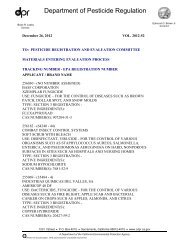Dichlorvos (DDVP) Risk Characterization Document - California ...
Dichlorvos (DDVP) Risk Characterization Document - California ...
Dichlorvos (DDVP) Risk Characterization Document - California ...
Create successful ePaper yourself
Turn your PDF publications into a flip-book with our unique Google optimized e-Paper software.
Dietary Exposure<br />
DPR evaluates the risk of exposure of an active ingredient in the diet using separate processes: (1)<br />
risk is determined for total exposure based on detected residue levels, and (2) risk is determined for<br />
exposure to an individual commodity at the tolerance level (VI. TOLERANCE ASSESSMENT). For the<br />
evaluation of risk from residues, the total exposure in the diet is determined for all label-approved<br />
crops (raw agricultural commodities) and their processed forms as well as any secondary residues in<br />
animal tissues. The degradation products and/or metabolites of the active ingredient which have<br />
established tolerances or whose toxicity is of concern are also considered in the assessment.<br />
Chronic dietary exposure estimates calculated by DPR were compared to those determined by<br />
USEPA (Schaible 1994 and 1995). These estimates were considered because residue values used<br />
by USEPA were adjusted for percent of crop treatment and reduction due to processing; thus, they<br />
represented a more realistic estimate of dietary exposure compared to those by DPR.<br />
Residue Data - general<br />
The sources of residue data include surveillance programs conducted by the DPR and federal<br />
agencies, field trials, and survey studies by registrants. Residue data obtained from the monitoring<br />
programs are preferred for human dietary assessments since they are a more realistic estimate of<br />
potential exposure. When residues are at levels higher than established tolerances, they are not<br />
utilized in the dietary exposure assessments because incidents are investigated by the DPR Pesticide<br />
Enforcement Branch and are relatively infrequent (consistently less than 1 per cent incidence<br />
according to the DPR residue monitoring programs). DPR evaluates the potential risk of overtolerance<br />
samples under a separate process referred to as an expedited acute risk assessment. In<br />
the absence of any measured residues, the DPR dietary exposure assessments utilize surrogate data<br />
from the same crop group as defined by USEPA or theoretical residues equal to USEPA tolerances.<br />
There are two elements in the DPR residue testing program which are currently used for dietary<br />
exposure assessment: Marketplace Surveillance and Priority Pesticide. Marketplace Surveillance is<br />
designed to ensure that the pesticides are used according to the <strong>California</strong> laws and regulations.<br />
Sampling in this program is weighted toward such factors as patterns of pesticide use, relative number<br />
and volume of pesticides typically used to produce a commodity, relative dietary importance of the<br />
commodity, past monitoring results, and extent of local pesticide use. Priority Pesticide was instituted<br />
to target commodities known to have been treated with pesticides of toxicological concern.<br />
The U. S. Food and Drug Administration (FDA) has three monitoring programs for determining<br />
residues in food: (1) regulatory monitoring, (2) total diet study, and (3) incidence/level monitoring.<br />
Depending on the program, raw agricultural commodities and/or processed foods are collected for<br />
analysis. For regulatory monitoring, surveillance samples are collected from individual lots of<br />
domestic and imported foods at the source of production or at the wholesale level. In contrast to the<br />
regulatory monitoring program, the total diet study monitors residue levels in foods in forms ready for<br />
consumption (Gunderson, 1988). The consumption patterns of 8 population subgroups are based on<br />
the USDA 1977-1978 Nationwide Food Consumption Survey and the 1976-1980 National Center for<br />
Health Statistics' Second National Health and Nutrition Examination. From these surveys, 234 food<br />
items were selected to represent the 5,000 foods identified. The individual food and necessary recipe<br />
ingredient items were collected from 4 broad geographic areas each year. The food items, after<br />
preparation, were analyzed by multi-residue analytical methods. The incidence/level monitoring<br />
program is designed to address specific concerns about pesticide residues in particular foods.<br />
63
















